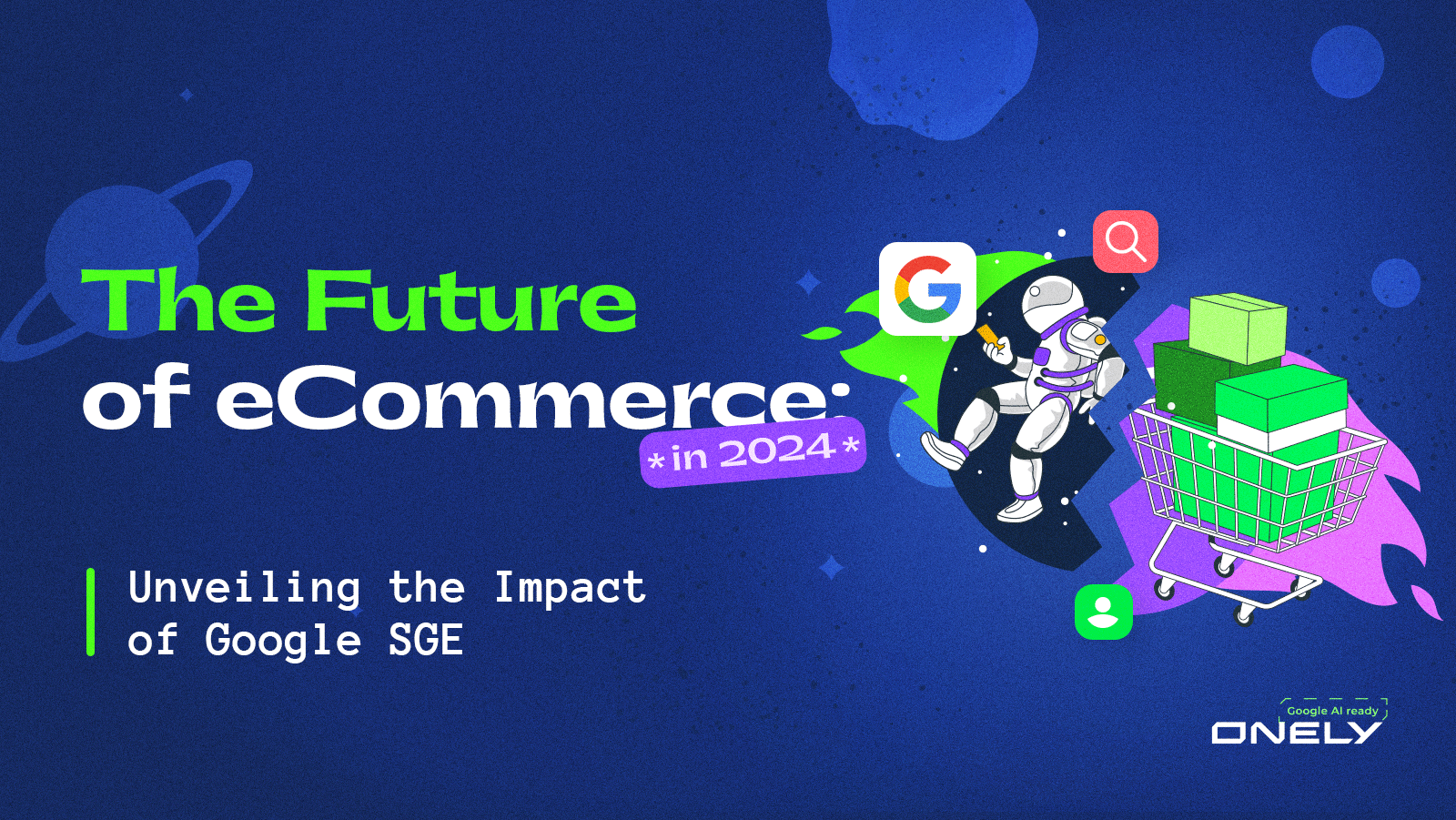
TL;DR
Google’s Search Generative Experience (SGE) is shaking up the world of online shopping.
Previous major changes to Search, like the introduction of featured snippets or rich results, typically affected a single stage of the buyer’s journey – the top of the funnel.
But SGE is designed to appear throughout the eCommerce funnel, from product comparisons to researching features to aggregating product reviews fetched from all around the web. More importantly, it’s designed to guide the user toward a purchase without leaving the SERP.
The result is an experience that not only saves the customer’s research hours but also allows users to always find the best deals — all while sending little traffic to the actual retailers.
After 10 months of research, I’m ready to present the results of multiple experiments and data analyses we ran to understand this upcoming revolution.
My conclusion is clear: SGE will completely transform organic acquisition for eCommerce stores from the top to the bottom of the funnel.
In this article:
- I’ll show you exactly how SGE will soon impact the buyer’s journey of every Google user.
- I’ll explain how Google made it happen and why it aims to move the shopping experience onto the SERP.
- And finally, I’ll suggest ways to get ready if you’re in eCommerce.
Key takeaways
- SGE streamlines product research into one smooth experience, keeping users away from retail websites until they’re ready to purchase.
- The SGE algorithm differs from the traditional Google search algorithm, with 43% of SGE sources not ranking in “old Google” for the given query.
- Even if your current rankings are fantastic, they don’t guarantee SGE inclusion. Just 17% of SGE-enabled queries reference pages currently rank #1-3 for the given query.
- Google’s Search Generative Experience (SGE) is enabled for 87% of eCommerce queries: SGE aims to control the entire buyer journey, from research to checkout, making it faster and more efficient.
- SGE is used with similar frequency for all types of queries from short- to long-tail.
- Since SGE appears for 97.5% of queries with a high cost-per-click (over $5), you can prevent your future ad spend from skyrocketing by turning to SGE optimization.
- SGE prefers to use lightweight websites as sources and eagerly cites content that is readily available in the source HTML without any JavaScript execution.
- SGE replaces featured snippets for most queries, effectively replacing this search feature for eCommerce queries.
- 71% of the SGE results we analyzed contained a YouTube video. Thanks to Google’s Gemini, SGE can highlight specific video fragments, catering to users’ preferences based on their immediate information needs.
- On average, SGE uses five websites as sources to generate its output.
- eCommerce businesses can and should adapt their acquisition strategies to leverage SGE’s features by making their websites leaner and providing appropriate content along the buyer’s journey, which aligns with what SGE wants to serve to Google’s users.
- Google’s SGE is continuously evolving, and you should closely monitor trends and updates to stay ahead of the competition.
This new landscape presents new challenges, but if you are an early adopter, this is nothing but an opportunity. eCommerce businesses must rapidly adapt their content strategies, embrace technical simplicity, and understand how to leverage SGE’s functionalities to thrive in this evolving landscape.
SGE needs to save Google’s AI motion
Google’s Search Generative Experience (SGE) is not only a revolution, it’s Google’s attempt to maintain its leading position in search after:
All that is on top of Google’s mass layoffs in pursuit of resources to fund the company’s transition towards AI.
Google definitely feels the heat: its position as the ultimate search engine has never been weaker. But if Google plays its cards right, SGE might be its way out. The stakes are higher than the problems that Google is facing.
Our research has shown that what might be Google’s way out is a critical threat to eCommerce stores.
Google SGE isn’t just another update — it’s a shift in how we interact with Search. It’s a fully functional experience you can use today. And the chances are you’ll **** it, get hooked, and never go back to “regular” Google.
Let me start with what I believe to be the most significant shift from the traditional search to immersive, fully adaptive user journeys: user journeys that are so fast that compared to regular searches, they feel like a Tesla racing a rusty old truck.
Google SGE has little to do with the search engine we know and use right now.
Buckle up!
Part I: State of SGE & eCommerce
SGE will change the way we shop online
The times of reading 2000-word articles and life stories of tech bloggers when trying to find the best road bike or microwave oven are behind us.
SGE makes product research easier, faster, and more immersive than ever. It focuses on making complex purchases and user journeys quick, efficient, and addictive.
Google SGE can fetch the product specs and reviews from multiple sources and summarize them into a 30- to 90-second read.
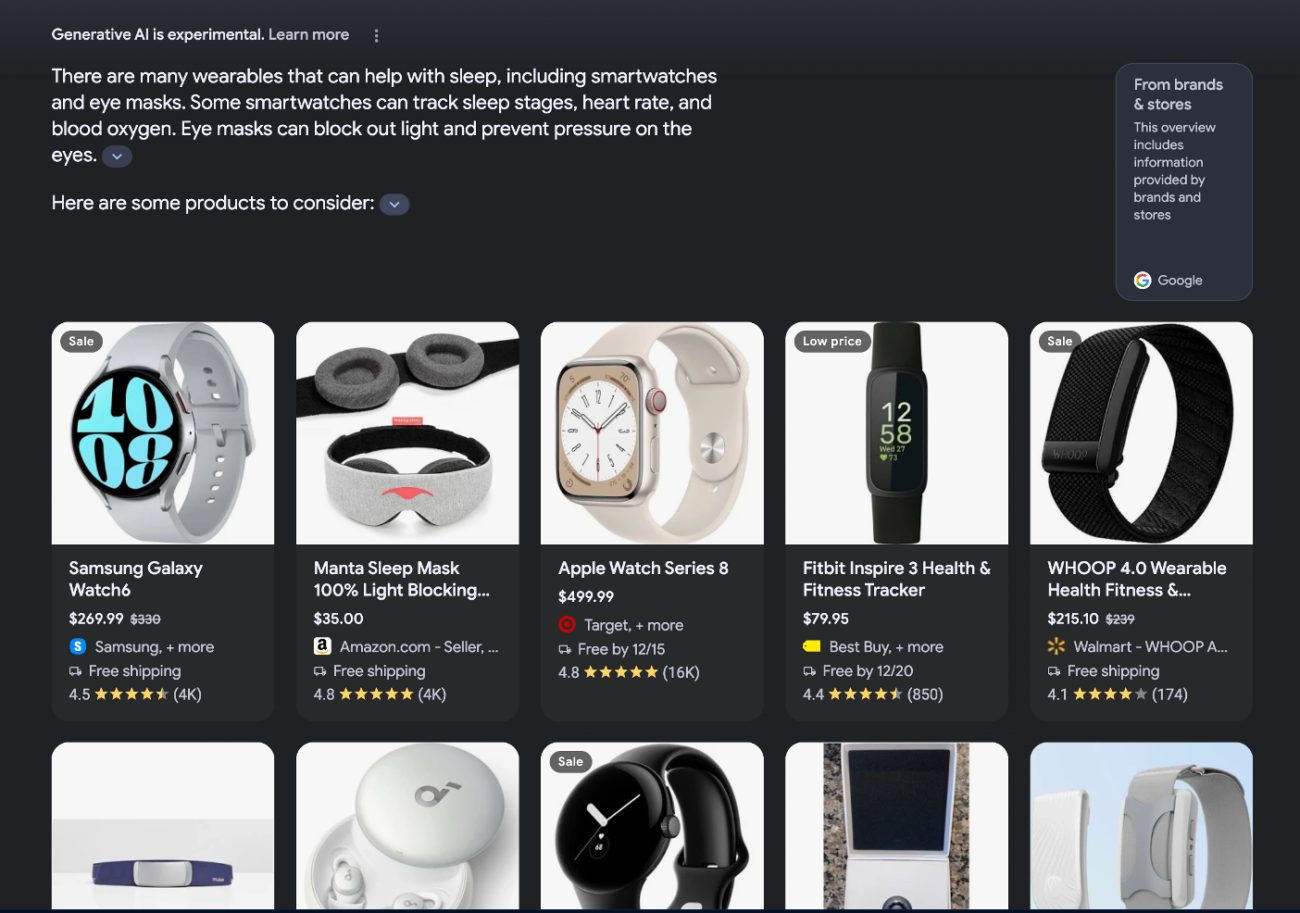
Most SGE results can be read fully within less than 2 minutes.
However, they still efficiently demonstrate the benefits of the products and even the pros and cons fetched from millions of product reviews available across the web.
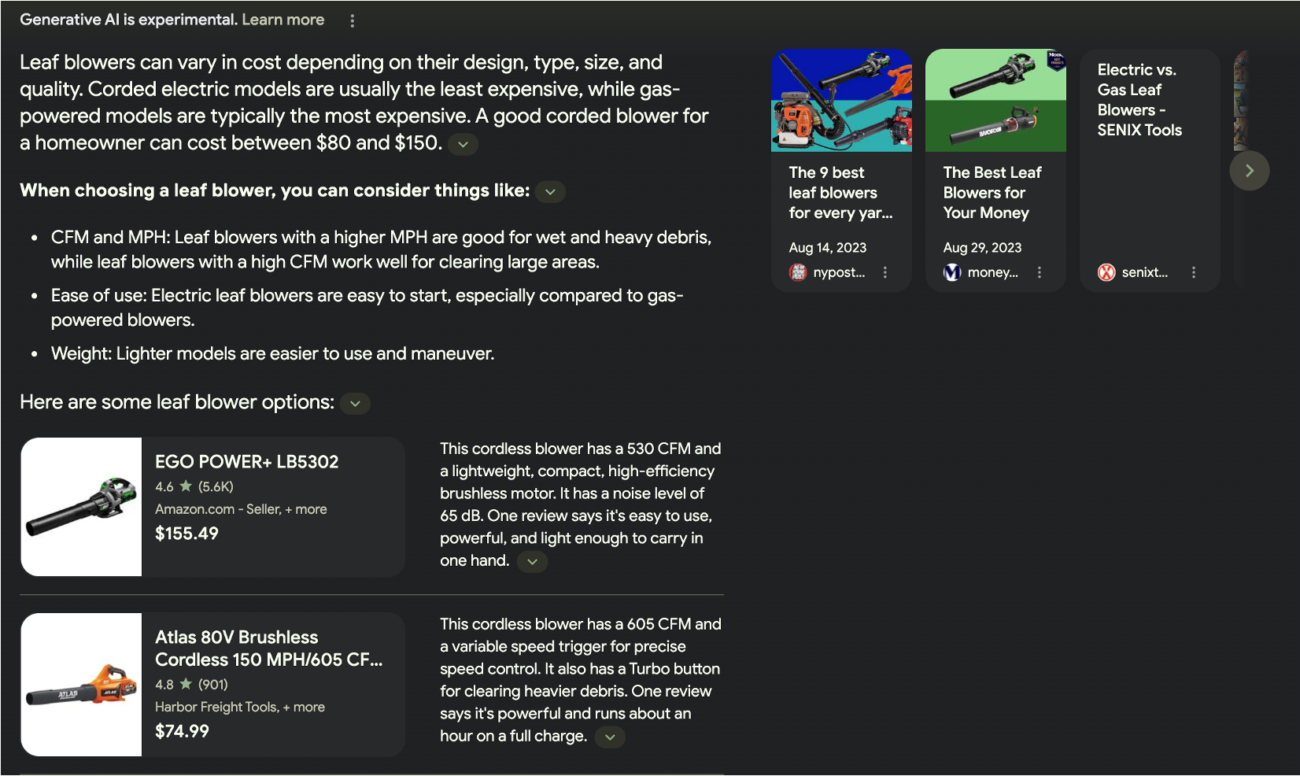
And on top of combining multiple data sources, Google leverages its research on different media formats, merging them all into one single result page.
It’s also amazing how SGE can let you directly compare two competing products within seconds.
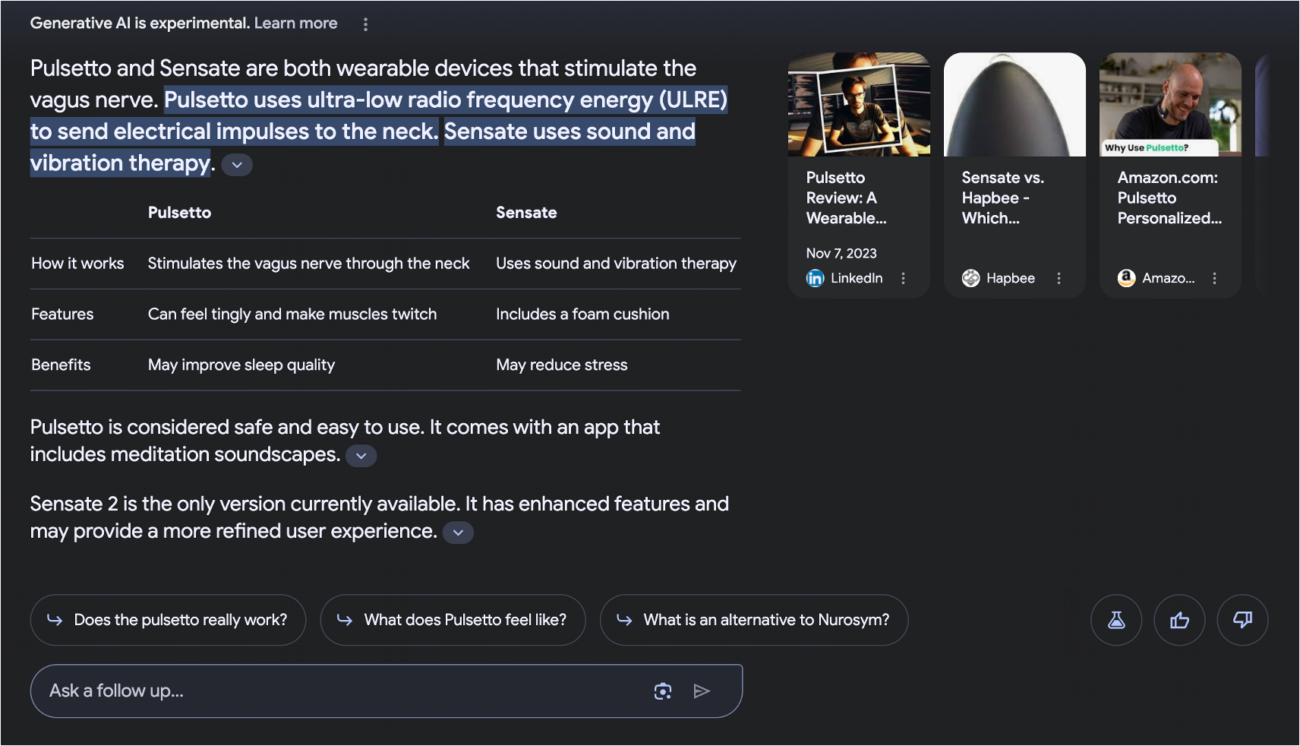
Which… makes you ready for the purchase. Imagine completing your research on whatever you want to buy and being presented with all the data available on the product you are interested in in one place.
And I mean ALL of the stuff, like:
- User reviews from all around the web
- Product images fetched from multiple stores
- Product variations
- Product availability
- Shipping rates & return terms
- Price history
- Price compare
- Used & budget options
- Forum conversations related to the product
For some queries, Google SGE can even retrieve coupon codes.

Knowing about Google’s intense competition with Amazon, I am not surprised to see how aggressive the final stage of the SGE consumer journey is.
As you can see, Google packed many features into Google SGE to make user journeys more efficient.
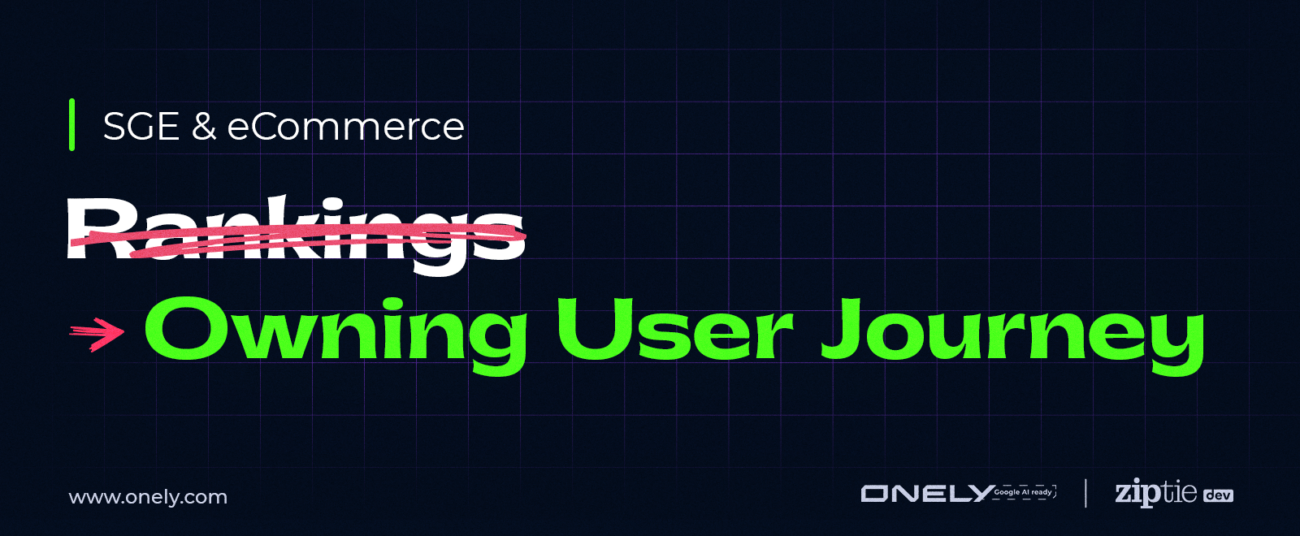
SGE puts an end to Google’s bland UI. It delivers an entirely different user experience and shows different data points depending on where you are in the user journey.
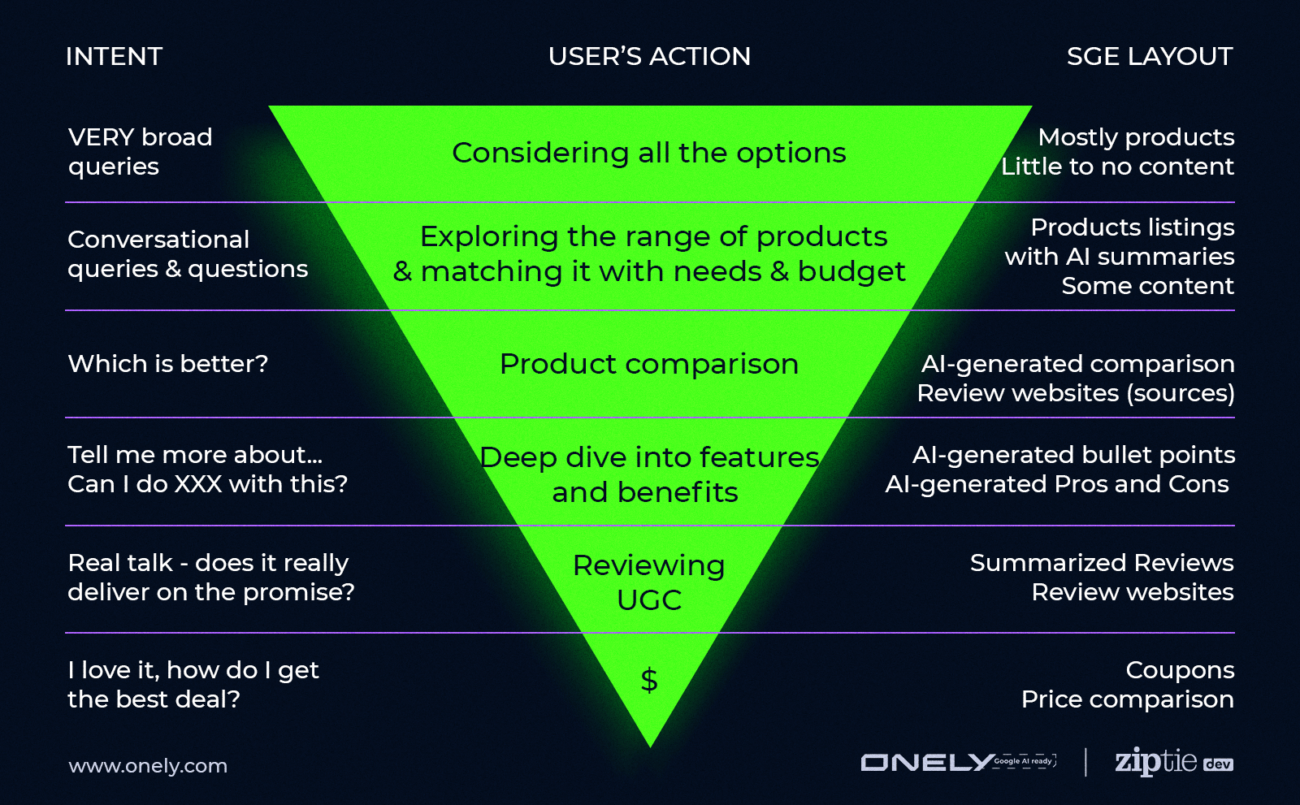
By aggregating data from multiple databases and serving it precisely when the user needs it, Google SGE could be a viable competitor to Amazon. I believe that this brings a significant opportunity for the first stores that will go heavily after Google SGE optimization.
43% of Google SGE sources don’t rank in “old Google” at all for the given query
Our data couldn’t be more clear on this part. Undoubtedly, Google SGE is powered by a completely new and different algorithm that has little to do with the good old Google.
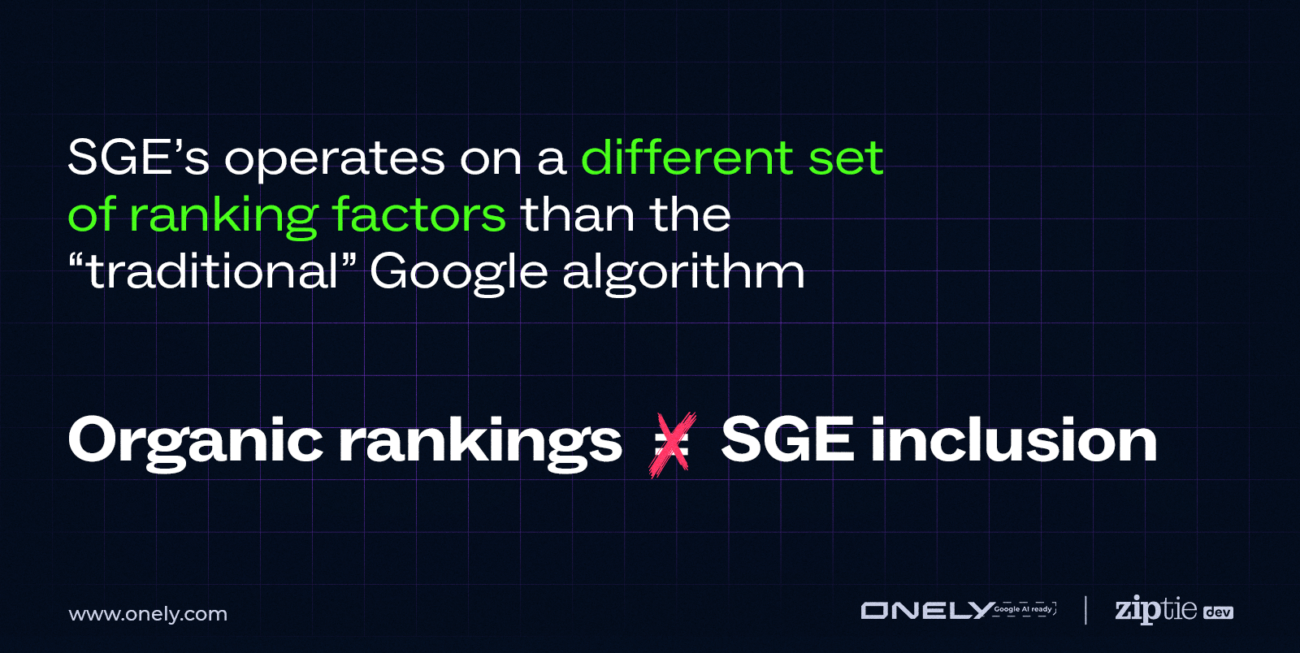
In other words, your existing rankings don’t guarantee you’ll thrive as the SGE user base grows. However, our data shows that if you’re ranking in the top 10 for a given query, your **** of being used as an SGE source are better than if your ranking is lower.
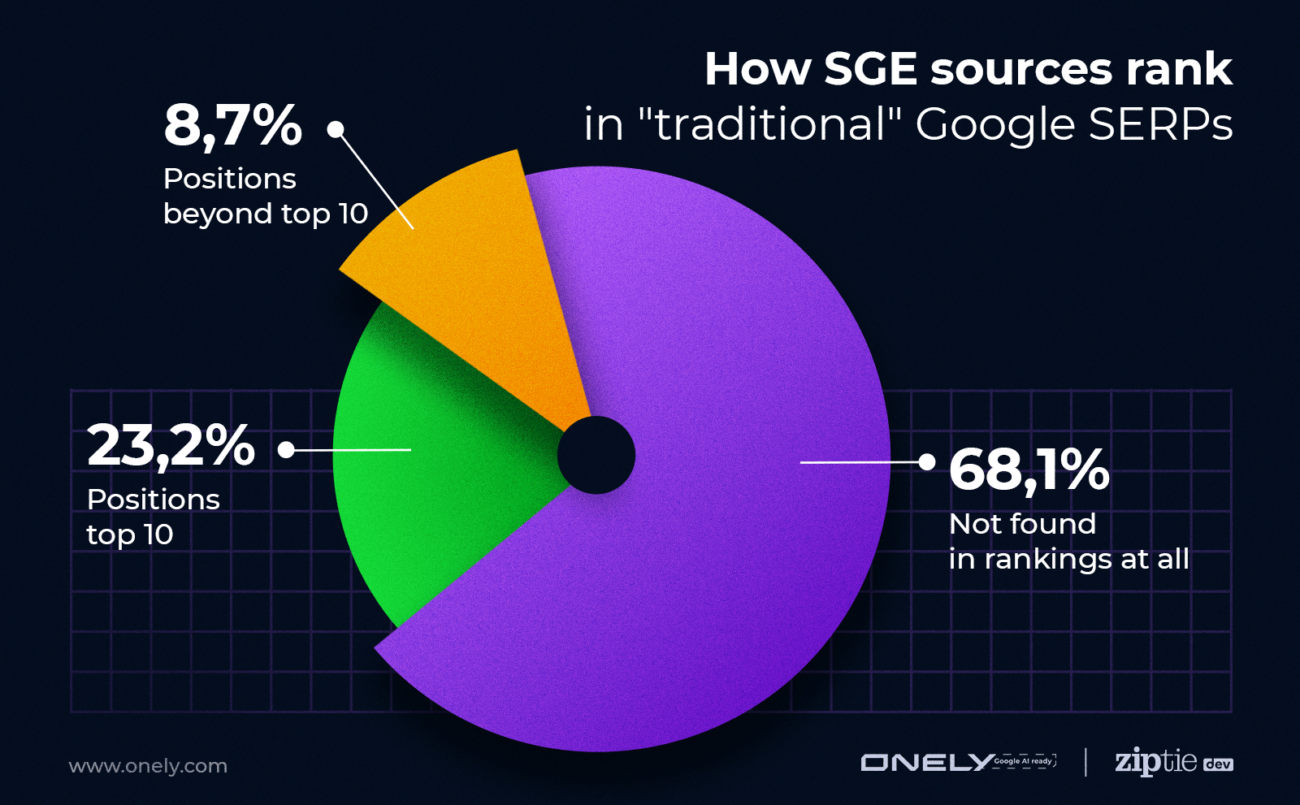
Pages ranking 1-3 in “old Google” are only used by SGE 17% of the time
Even ranking on the top doesn’t guarantee your content will be used in SGE. In fact, the correlation is barely there.
SGE will affect 87% of eCommerce organic traffic
Of the 24 thousand eCommerce queries we analyzed, 87% generated an SGE response, and only 13% returned the classic Google Search page.
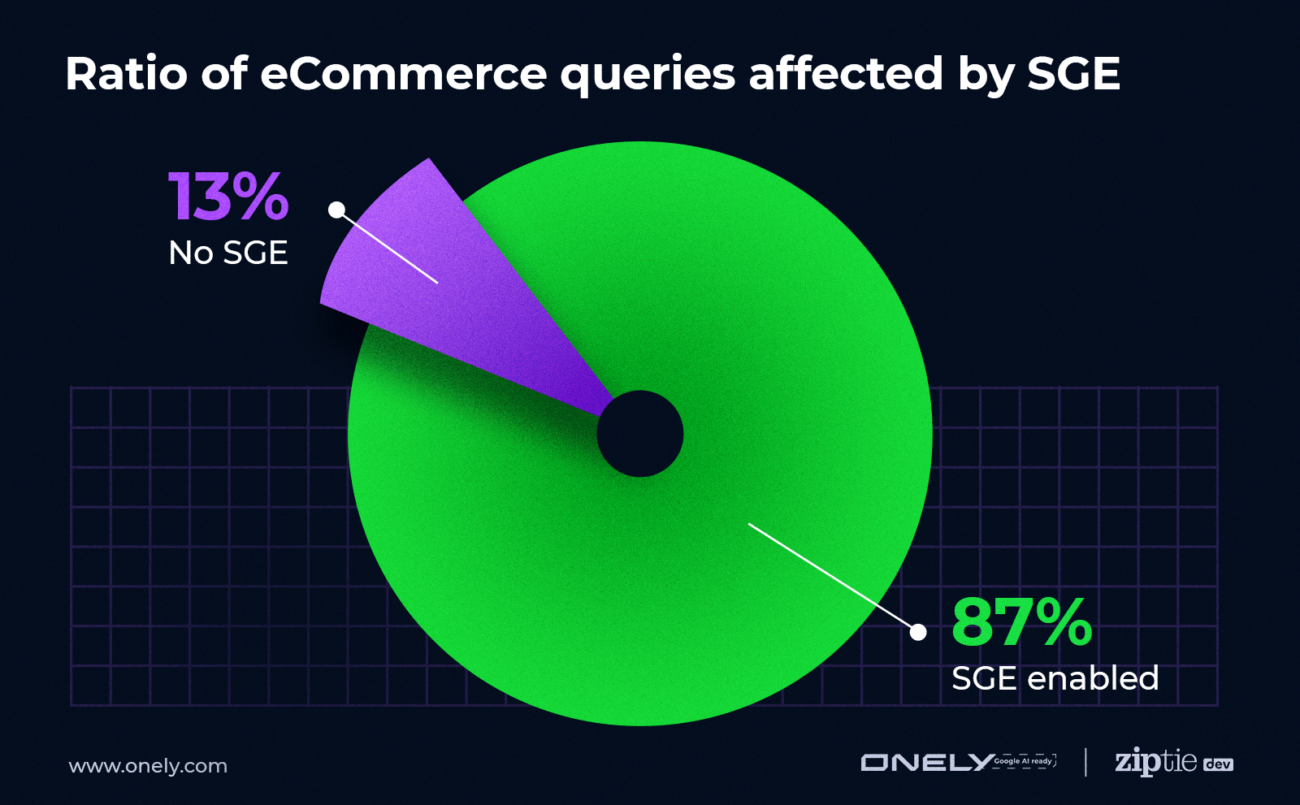
While a near-90% coverage is impressive, what I didn’t expect to see in our research is that Google enables SGE even for less popular queries.
SGE is used across queries of any length
Whether it is a shorter query like “Apple watch” or a long-tail query like “USB-C charger for iPad 10th generation,” Google’s SGE displays for the vast majority of all eCommerce searches (between 82% and 89%, depending on the query length.)
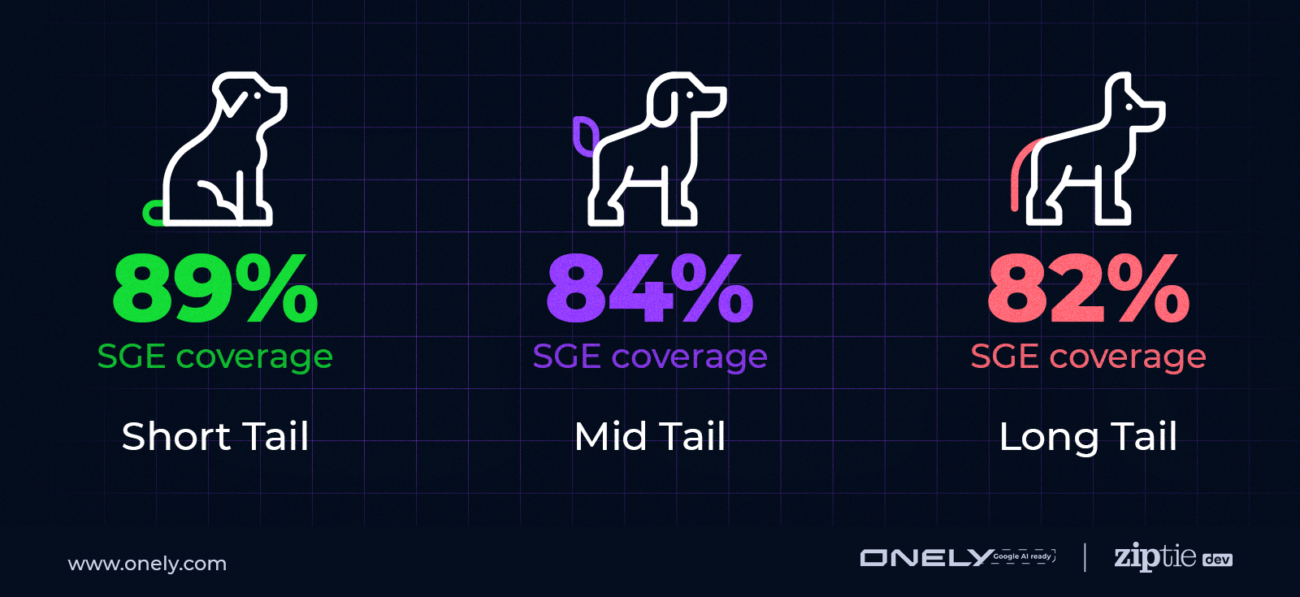
So whether your store is focused on uber-popular queries or you are selling niche products with lower search volume, expect to see Google SGE in the SERP near you.
SGE affects 97.5% of high-PPC queries
The e-commerce industry is buzzing with speculations regarding how Google Ads’ cost will be affected by Google’s Search Generative Experience. PPC has always been a fallback for online stores in providing a steady flow of leads when they aren’t successful with SEO.
While Google SGE is used for 87% of all eCommerce queries, this ratio jumps to 97.5% coverage when the PPC cost exceeds $5. In other words, the more expensive a given query is, the more likely SGE will be included in the search results.
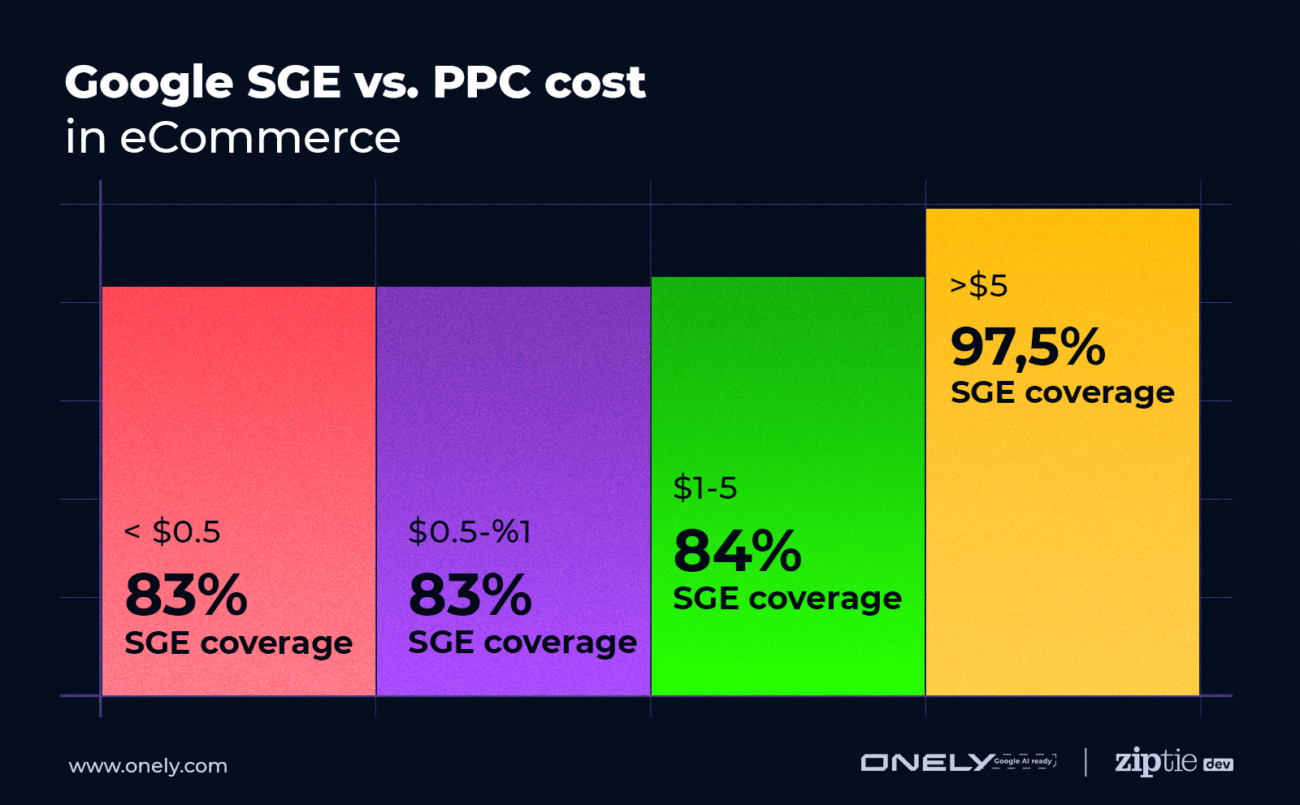
My prediction is that Google SGE might affect PPC cost and increase the demand for ads in the time of transition. Online stores going after higher PPC queries may consider becoming Google SGE optimization first movers to mitigate the risk of increased ad spend that could push them outside the ROI bracket for some of their products.
SGE prefers lightweight websites
What’s been Google’s & Bing’s most significant technical challenge over the last few years is also what all the large language ****** struggle with – adding complexity to their products makes them more resource-hungry.
As OpenAI’s Sam Altman said, the age of AI will require an “energy breakthrough.”
However, until we see that breakthrough, Google will promote and prefer lightweight websites because they require fewer resources to be spent on Google’s end.
For over a decade, we have seen an incremental move from Google towards promoting lightweight, distraction-free, fast-loading websites. From page speed being included in the algorithm in 2010 to the 2016 launch of AMP, the message from Google has been clear: Fast is better!
With SGE, Google is saying fast is essential, essentially focusing on content in the HTML body of your website, ignoring JavaScript and complicated code structures. Although that may change in the future, if you want your website to be featured in SGE today, you will need to ensure it is simple and that all vital information can be seen immediately without additional clicks or actions.
Our tests show that SGE has a strong preference for serving content that’s readily available in the HTML body.
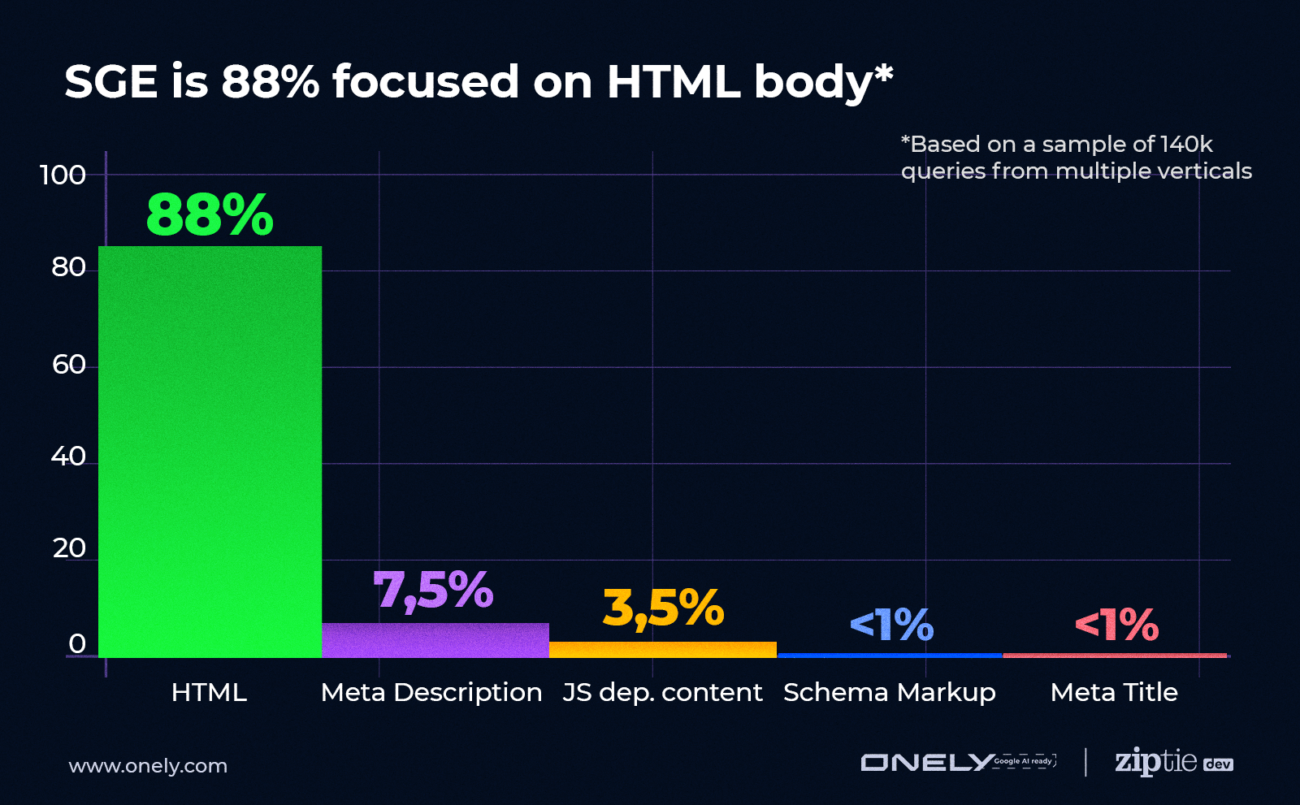
Furthermore, pages SGE picks as sources are lighter on the JavaScript execution side.
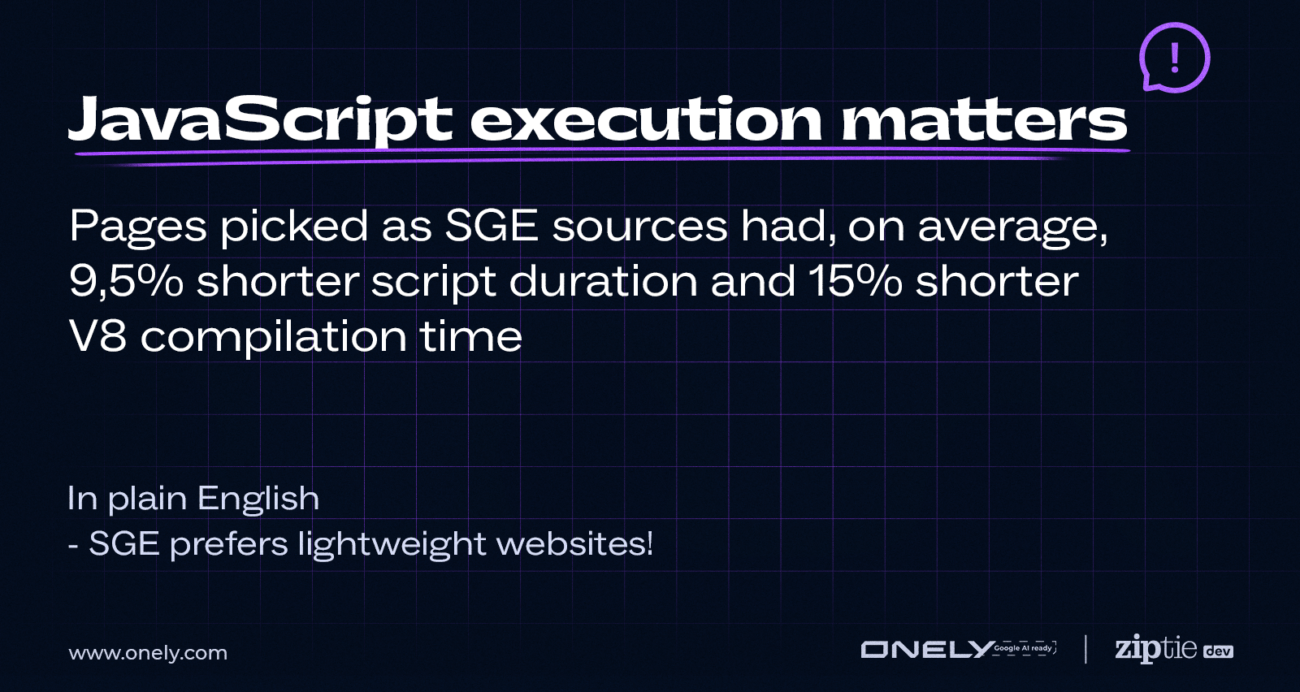
SGE will likely replace featured snippets
In the SGE realm, featured snippets lose their former glory, with only 1.4% of all queries sampled during our analysis showing featured snippets compared to 85% of Google results displaying AI-generated Google SGE responses. While both featured snippets and SGE are focused on keeping users on Google, the similarities end here. Even though featured snippets were a revolution in search, Google SGE takes it to another level thanks to its expanded interactivity.
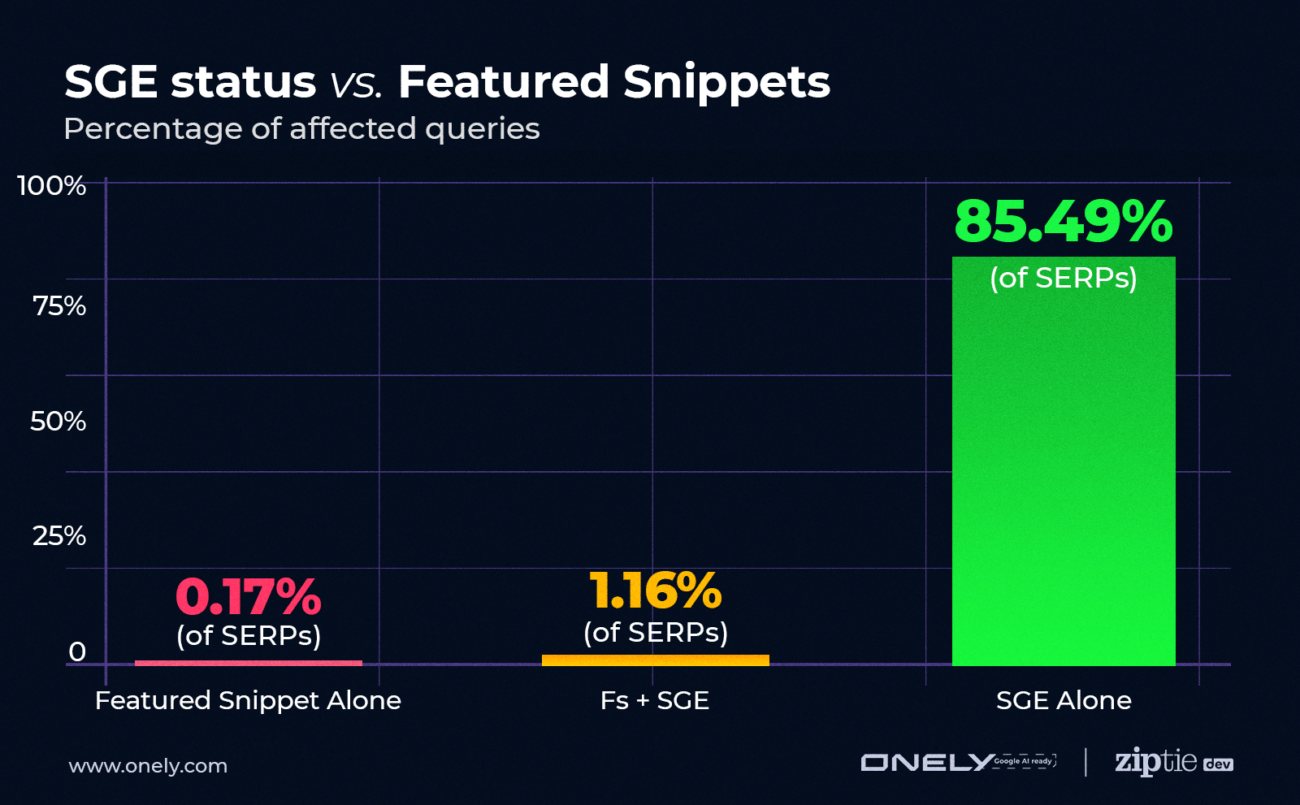
71% of SGE results in the eCommerce space feature a YouTube video
It’s no secret that video now plays a significant role in the buyer’s journey.
According to Google’s Bethany ****, “80% of people are going back and forth between search and video on their consumer journey.” However, only 50% of this traffic is directed to Google-owned YouTube.
SGE might increase this ratio by pushing more users to YouTube content that directly matches their query.
Thanks to Gemini, Google is no longer limited to text. Google can understand all media and content formats, including videos, images, or podcasts. Showing video itself is familiar in search, though the video focus within Google SGE is much higher than ever at Google.
What’s also new is that Google SGE highlights only a specific fragment of the video’s content that directly answers your query. All that underneath AI generated summary.
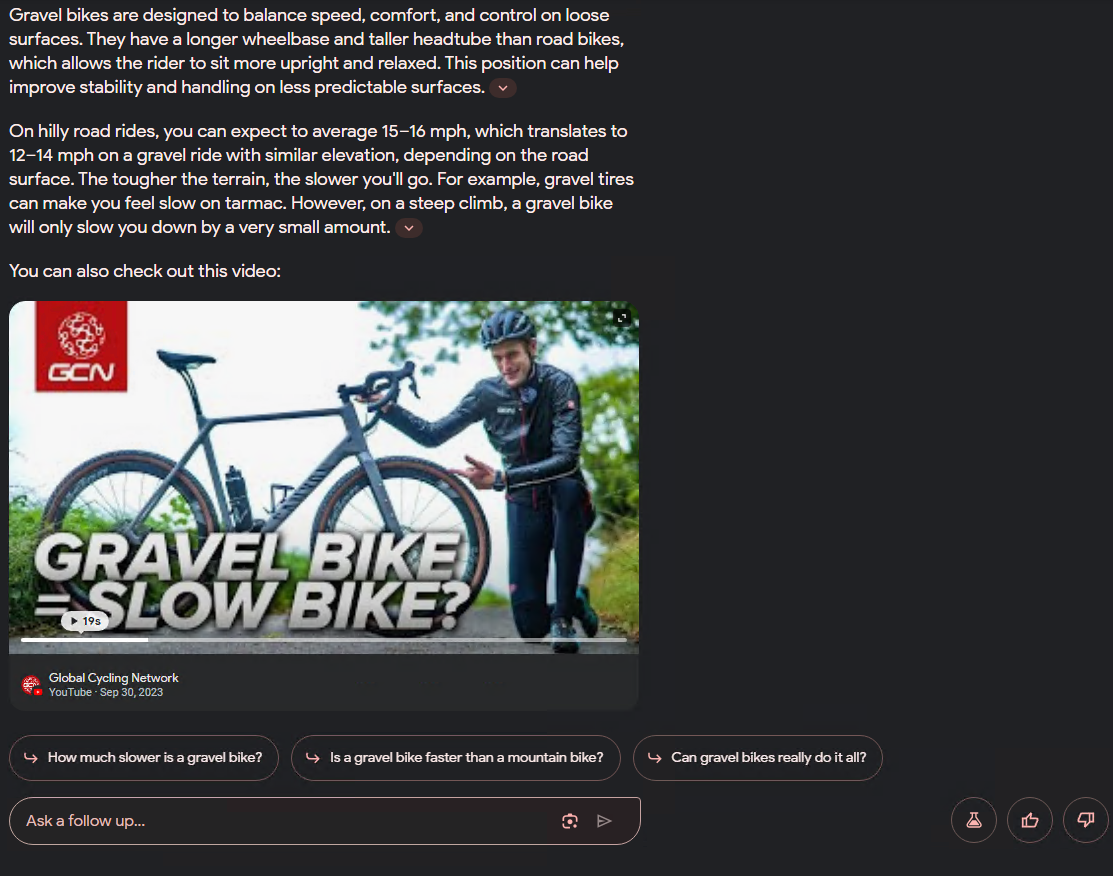
What would take 5 to 6 searches and likely require visiting multiple pages now effectively takes less than 2 to 3 minutes and happens directly within the SERP.
On average, SGE quotes five sources in the AI-generated response
Google SGE fetches and presents an average of 5 SGE sources/articles from their database, finds common data points from all the content, and summarizes them in a concise format.
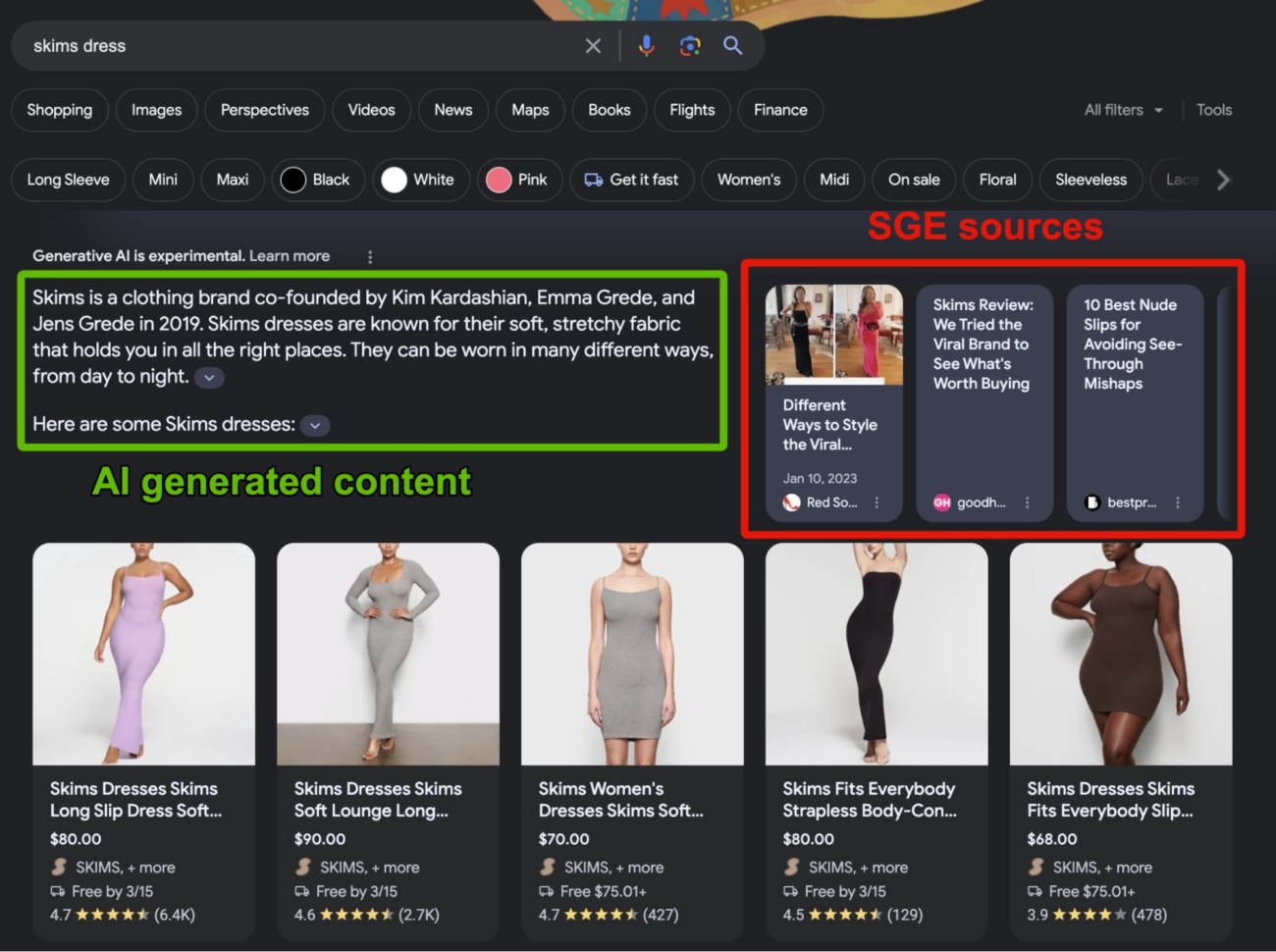
I believe that this is Google’s answer to their research, which shows that consumers now need more information to make a decision.
“Consumers are engaging in information seeking to a much greater extent than they ever did before.”
With SGE, touchpoints with each piece of information are condensed and made more digestible thanks to the use of mixed media.
And for those of us who like to dig deeper, SGE guides us through the next steps of the journey.
Below, you can find an example of clickable follow-up questions.

In most cases, I’ve found these to be shockingly precise, almost as if Google was tracking users for years to understand their next move…
Part II: How Google got here
Google likely owns the world’s most extensive database of user behavior patterns.
In fact, documents revealed by Google in their 2020 antitrust trial showed that Google was using user engagement data not only for ranking purposes.
A screenshot from the trial’s evidence below tells quite an interesting story.
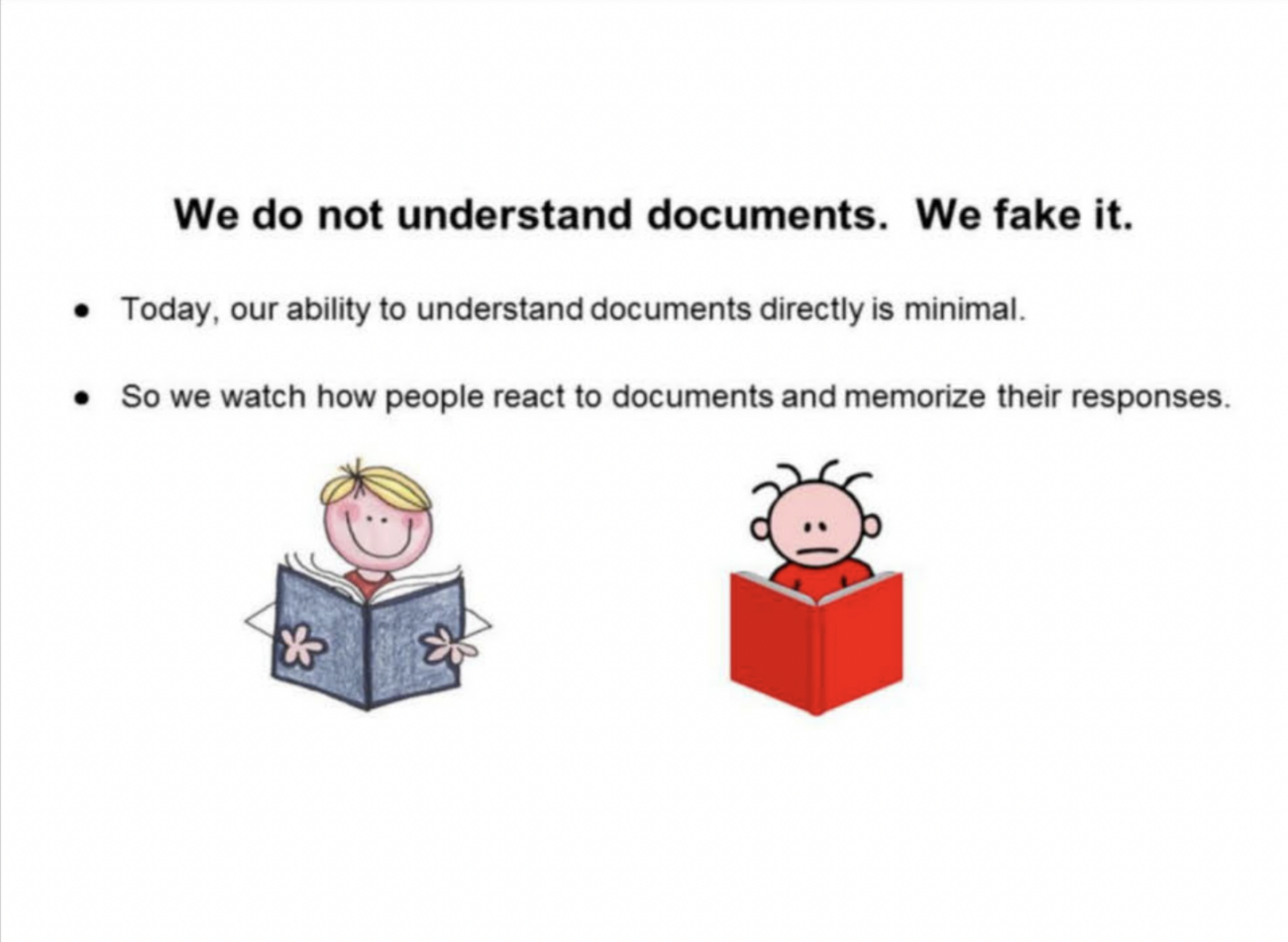
In fact, Google has admitted to using clicks, hovers, and everything in between to predict the user’s next move.
We’ve been unknowingly training Google on what we want and how we want it for years. Billions of users send Google a constant stream of information about their preferences every day. Their bland UI was their greatest ****** as it made it easy for Google to learn about users and predict their next move.
As Google’s Allan Thygesen said:
“The opportunity to marketers is not just meeting them there at the moment, but anticipating where that journey is going and what that need is and responding there at the moment.”
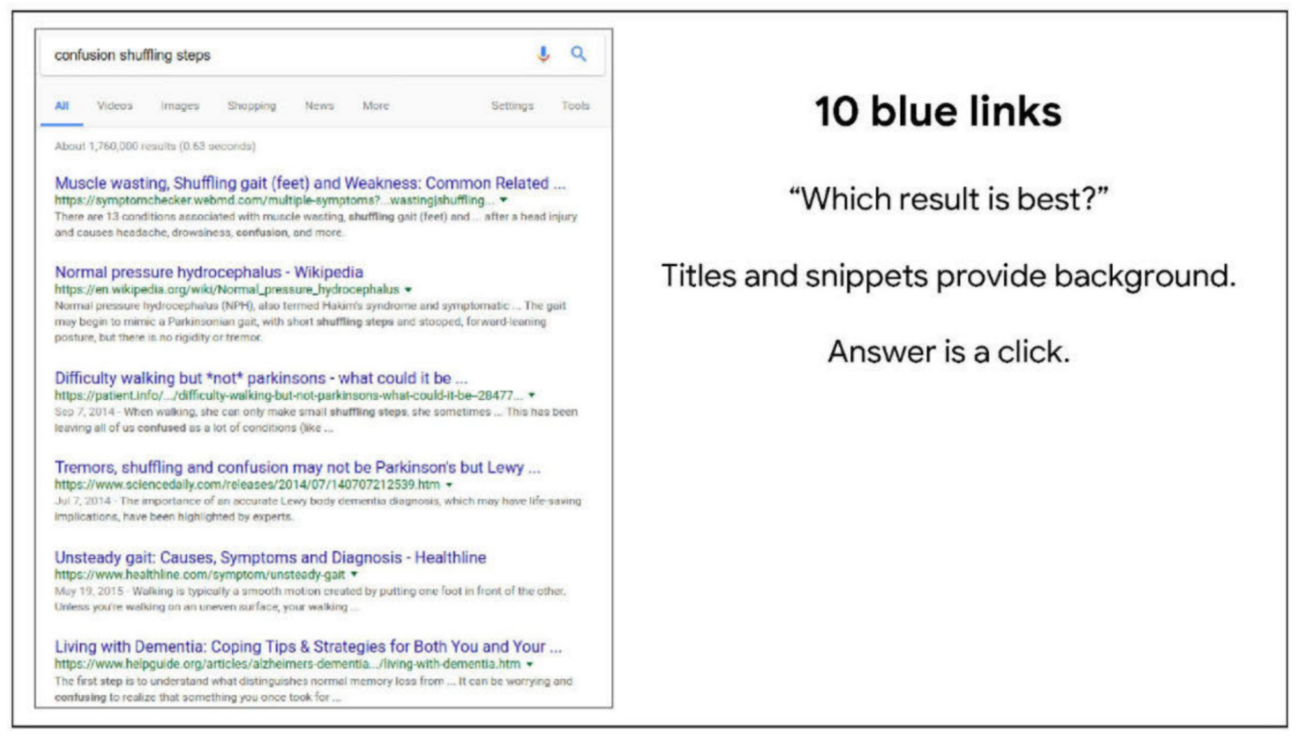
“For years. Google was mocked for great search results in a bland UI. But this bland UI made the search results great.”
When we combine Google’s 35 billion product listings, Google’s search index, and its ability to deeply understand and predict consumer behaviors, all we need is generative AI, and what we get is… Google SGE. In hindsight, it’s pretty evident that this product needed to be built and used for eCommerce queries.
Part III: How you should react
Most websites still operate based on the belief that more content = more traffic.
This statement was never more wrong than it is in 2024. This idea comes from the old age of SEO when it was believed that having more content would help you rank higher.
Adding a “wall of the SEO text” to category pages (screenshot below) is still a technique that most large brands use out of fear of losing their rankings.
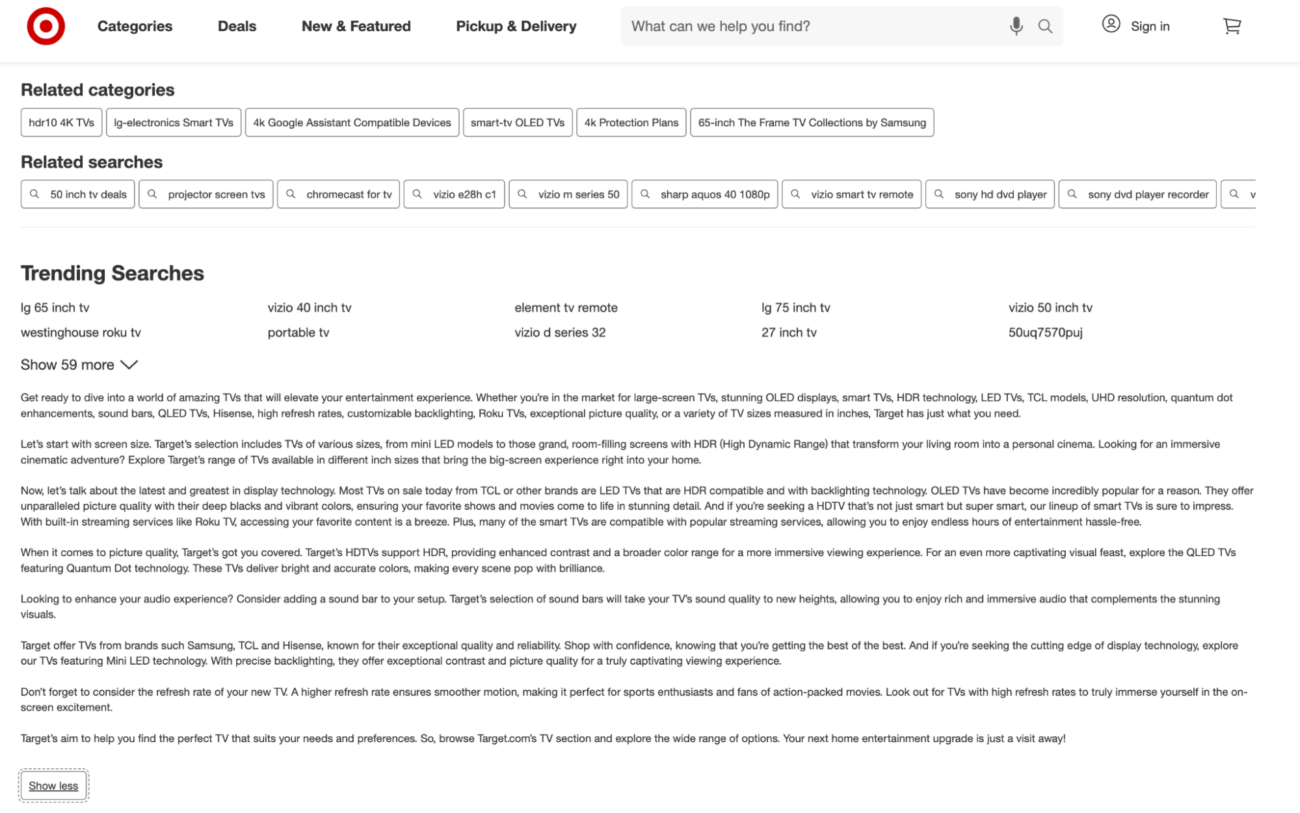
I highly recommend reading our research on how removing SEO text often leads to ranking improvements, as in the case of Zillow & Trulia.
I firmly believe that when working with eCommerce, having content is valuable only if your users will read it or interact with it. The era of creating content only for search engines is long gone.
How to get into SGE content carousels?
Google SGE picks out content based on a different set of metrics. It seems not to be focused on the whole page/URL; instead, we see many cases where a fragment of text will be picked by Google SGE from an article that’s not directly related to the query. As long as the part of the content used by Google SGE is the most straightforward answer to the user intent, you are moving in the right direction.
We have identified many of the SGE factors that influence the inclusion of your content in SGE carousels. Although it would take another complete article to explain them all and how the factors need to stack together for inclusion, the top factors we see working are as follows.
- Concise content closely matching the user intent (query).
- Complex topics explained using bullet points or steps.
- Summarized user-generated content – e.g., summarized product reviews with pros and cons.
- Shifting from keyword focus to user journey focus.
- Hijacking user journeys and SGE-suggested follow-ups.
- Leveraging “top X best Y” article format, e.g., “Top 5 best leaf blowers.”
- How to do X in Y steps.
- Be brief and to the point.
- Skip adding your life story to every product review (this one is 100% not data-driven and based on my personal frustrations) 🙂
Tools & optics
- ZipTie.dev for Google SGE intelligence & monitoring
- Revere for copilot monitoring
Technology
Even with the best possible content optimization, our research points out that one of the most vital signals for Google SGE is your website’s technology:
- JavaScript execution time.
- Content visible without JavaScript dependencies.
Technology is so far the most decisive metric when optimizing for Google SGE. We’ve managed to get pages into Google SGE in as little as four days, working only to make the pages leaner and more accessible to digest for Google.
How to mitigate Google SGE rollout risks for eCommerce
Looking at the data, we can see that Google SGE is eCommerce’s first major AI challenge. With almost 90% of organic traffic interacting with Google’s generative AI throughout the consumer journey, understanding this revolution is critical. Fortunately, besides gathering tons of data on Google SGE, we’ve been working with some of the world’s largest brands to prepare them to build the ultimate Google SGE framework for this shift.
Google SGE optimization walkthrough
Even though Google SGE is pretty advanced already, we can expect a soft rollout over the next few months. This creates a significant opportunity and a first-mover advantage.
How do you ensure your store is on the Google SGE winner list?
- Focus on improving your technology.
- Even though most marketers focus on content throughout the AI revolution, right now, our research shows that it’s not the lack of content that’s driving poor SGE coverage for large brands. Ensuring that your Google coverage (indexing) is high and that search engines can easily digest your content is responsible for around 70% of success. These improvements will also affect your organic traffic from the “old” Google, creating a win-win scenario even on a tight budget.
- Gain optics to win. Start measuring your Google SGE inclusion and its trends.
- The answer lies in the data. Your data. Pattern recognition is key to a successful transition to any major change, including search engines and generative AI. Each brand will be affected differently, and without clear optics and trends gathered as early as possible, the risk of failure increases.
- Start tracking your Google SGE inclusion for top 500 – 2000 top queries (we usually aim for at least 90% of your organic traffic) weekly. Divide your content and URLs into winners and losers. Optimize losers and learn from the winners. You can use tools like ZipTie.dev to track your Google SGE inclusion automatically.
- Run A/B tests
- The sooner you create a workflow allowing you for Google SGE inclusion, the safer your organization will become in 2024. We regularly run small A/B tests for our clients. You can start by adding executive summaries to your long-form content, changing the format of your “Table of Contents” on top of the article to bullet points or simple steps, or coming up with a brief, actionable answer to a user query. Content optimization for Google SGE is not complex (sign up for our newsletter below to read our upcoming article on Google SGE content optimization). It drives rapid results once your tech stack is optimized correctly.
Google SGE is a shift for most brands. It’s a shift from getting clicks from Google to becoming a solution to the user’s search queries.
I believe shifting marketing focus from content-oriented to solution-oriented will be a crucial success factor for brands. Users will engage and build trust with brands that make their shopping experience easier and faster, taking away what consumers hate the most – lengthy research.
Google SGE and eCommerce Impact: Summary
Google SGE is more than an update; it’s a paradigm shift for eCommerce.
Traditional SEO metrics take a backseat, and eCommerce players, large and small, are already experimenting to find new best practices.
Throughout 2023, Google SGE was on the radar of only a few companies, but it’s gaining momentum in 2024. Just over the last few weeks, I spoke in front of the boards of Fortune Top 500 companies and multiple venture capital companies trying to understand Google SGE’s impact on their multi-billion portfolios, as well as small startups who see this as an opportunity to outrank the well-established industry giants.
Google SGE, generative AI, and Large Language Model Optimization are gaining traction and are here to stay.
From uncertainty to a data-driven excitement
eCommerce is at the forefront of this revolution, with some online stores we analyzed having almost 95%+ of their queries affected by Google SGE. While there is a lot of fear and uncertainty when I first talk to businesses concerned about this change, it always comes from tracking outdated metrics and not fully understanding the rules of this new game. Once you see that this transition is a data-driven and predictable process based on clear metrics, it becomes just another challenge that you and your team can tackle.
My observation from the forefront of Google SGE optimization is that even the most skeptical teams start to align and get excited about this shift once they see the first results.
Is your business ready for the Google SGE revolution?
Book your discovery call with us to stay ahead of the curve and leverage Google SGE to your advantage.
Behind the Scenes – our research methodology
We analyzed a mix of queries of various search volumes to get a comprehensive picture of SGE’s impact on the eCommerce vertical in the US.
We used ZipTie.dev to gather data on 20 thousand eCommerce queries and the URLs ranking for those queries in traditional Google and in Google SGE.
For each query, we also analyzed the layout, search features, and multiple other data points to get a complete view of how SGE impacts them.
Outside of the eCommerce research used for this article, we analyze 500k Google SGE queries from multiple verticals each month to spot new trends and changes that Google is working on.
This more extensive data set was only used to analyze the presence of featured snippets vs. Google SGE and the dependency between page weight & performance vs SGE presence.
Interested in Google SGE? Then you don’t want to miss this!
GOOGLE SGE – FIRST MAJOR AI DISRUPTION IN MARKETING. LESSONS FROM PREPARING THE WORLD’S LARGEST BRANDS.
Join our free webinar and learn how the CMOs can leverage the state of AI in 2024 to bring steady organic growth.
Our hosts Bart Goralewicz & Brent Csutoras will guide you through the process of SGE optimization. You’ll learn how to use SGE to get the ROI within a few months, meet your customer’s needs, and rank for SGE before your competitors do.
We guarantee well-proven solutions on what’s actually working.



